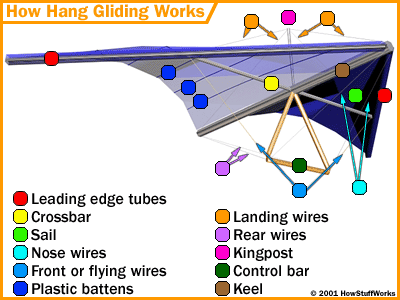Flying and Steering
A very large part of hang gliding is learning to get
in the air. In order to take off, the pilot has to run with the glider
and get the air moving across the wing at about 24 to 40 kph, depending on
the combined weight of the pilot and the glider. This is accomplished
by running down a slope usually and using the prevailing winds to your advantage.
Once you are moving fast enough, the wing creates enough lift to overcome
gravity and raise you into the sky. Here is an example of a take off:

Photo courtesy of: How Stuff Works
Once you have performed a successful takeoff, the
next challenge is to stay in the air. This is a problem because a glider
does not produce any thrust itself and therefore it is constantly losing
speed due to the drag
force. It is also being pulled down toward the ground by gravity.
So as you can see, there is a lot working against you, more than simply
the lift
generated by the wing could overcome. This is why thermal and ridge
lifts must be used to stay in flight, which were discussed earlier on the
lift
page. Professional hang gliders can stay in the air for literally hours at
a time simply by recognizing these phenomena. They look for places
where a lot of sunlight is drawn in, or by just watching the birds who use
these same columns of air.
Another concept in hang gliding that is somewhat of
a puzzle is turning. This is actually not very hard at all. The
pilot hangs by a harness from the center of mass of the glider. All
they have to do then is use the control bar (see picture below) to shift
their weight in the direction of the desired turn. This causes the
glider to tip slightly and a turn is executed.

Image courtesy of: How Stuff Works

Image courtesy of: How Stuff Works
The pilot can also use the control bar to change the
angle of attack, which was discussed on the lift
page. This causes the glider to speed up, if you pull back on the control
bar and tip the nose of the glider down, and to slow down and stall if you
push forward on the control bar. Normally you would not want to stall,
because that could send you into an uncontrollable tumble toward the ground,
but that is how you perform a safe landing in a glider. Once you are
close to the ground, you push forward as far as you can and stall the glider
and land upright on your feet.